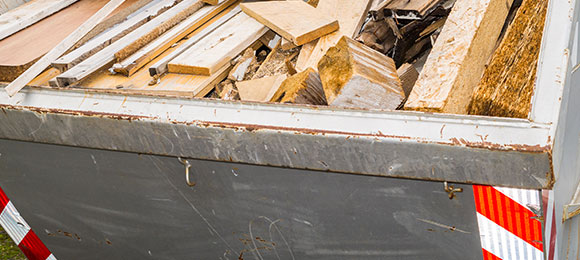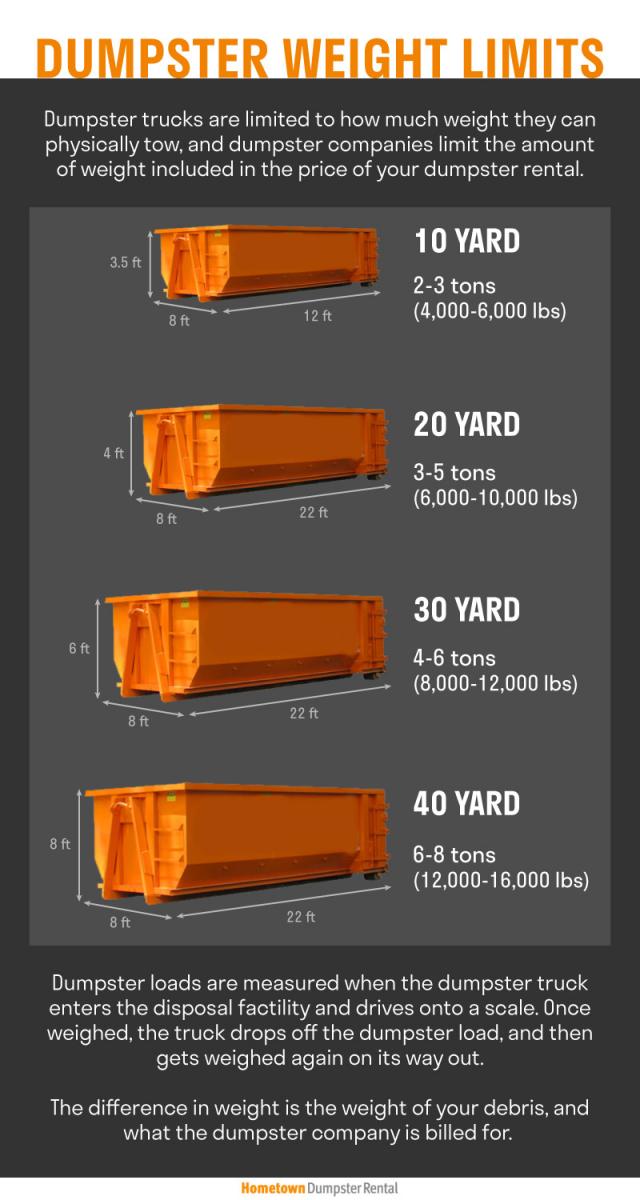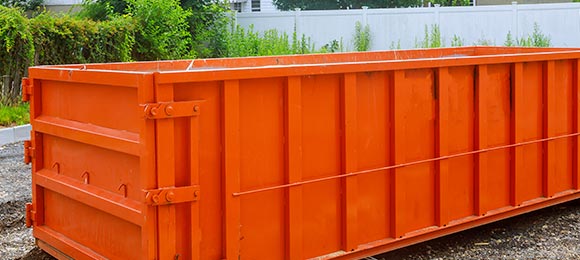
Updated July 16, 2025
When renting a dumpster, whether it be for a home renovation, construction project, or major cleanout, understanding the concept of a dumpster's weight limit is essential.
A dumpster weight limit refers to the maximum amount of weight that a dumpster can safely and legally hold, or the amount of weight included in your dumpster rental price. Exceeding this limit can lead to additional fees at best and safety hazards at worst.
Knowing the weight limit of your rented dumpster ensures that you can efficiently manage your waste disposal without unexpected costs or logistical problems. This knowledge allows you to plan your project better, select the appropriate dumpster size, and avoid overloading. Additionally, adhering to weight limits is crucial for maintaining road safety and complying with local regulations regarding waste disposal.
In this article, we will delve into the details of dumpster weight limits, explore the factors that influence these limits, and provide practical tips on how to stay within them. Whether you are a homeowner tackling a DIY project or a contractor managing a large-scale construction job, understanding dumpster weight limits will help you make informed decisions and ensure a smooth, hassle-free waste management experience.
Jump to:
- Why Dumpsters Have Weight Limits
- Weight Limits by Dumpster Size
- How Dumpster Weight Is Measured
- How Much a Full Dumpster Weighs
- How to Compare Limits and Pricing
- Are Dumpster Weight Limits Negotiable?
Find local dumpsters. Get real pricing.
Request availability and pricing from dumpster
rental companies near you.

Why Dumpsters Have Weight Limits
Dumpster rentals have weight limits for a number of important reasons. Here are the key factors why these limits are necessary:
Safety
Dumpsters are extremely heavy duty, sturdy containers, but the trucks that pick them up and carry them away have limitations. Dumpster trucks can only safely lift and maneuver so much weight, which is why companies limit the amount of weight that can go inside a dumpster.
Some companies won't pick up concrete or extremely heavy debris because of the risks involved, while others accept heavy debris but with very specific instructions, like only filling the dumpster halfway. If you exceed the halfway mark or don't abide by their instructions, you'll have to remove the debris before it can be hauled away, and you may be charged double.
Cost
In addition to safety purposes, weight limits are also in place for monetary reasons.
It's rare for a dumpster to have a flat fee because, at a landfill or recycling facility, the materials dropped off are almost always priced by weight. For example, a 10 yard dumpster full of some old furniture and bags of trash will weigh significantly less than a 10 yard dumpster full of concrete or dirt. So, even if the dumpsters are the same size and are rented from the same company, the dumpster full of concrete or dirt will cost more than the dumpster full of furniture and trash.
Because the company pays by weight when they drop off your debris/junk, they often include a certain tonnage in each dumpster's price. If you go over that weight, you will be charged an overage fee. Dumpster companies limit the amount of weight included in the price of your dumpster rental, and dumpster trucks are limited to the amount of weight they can physically tow.
Weight Limits by Dumpster Size
Each dumpster size comes with a different weight limit that it can handle, and weight limits also vary from one contractor to the next.
The table below details how much common debris and materials weigh. To get a more accurate estimation of how much your debris will weigh and how much will fit in various dumpster sizes, refer to the various charts below.
| Material | Weight per Cubic yard | Notes |
|---|---|---|
| Burned Debris/Ash | 800-1,000 lbs 1,500-1,800 lbs 2,300 lbs |
Loose/dry Wet for dust suppression Wet mixed with soil |
| Concrete Asphalt |
4,050 lbs 3,960 lbs |
|
| Wood, Un-Compacted | 400 lbs | Increase up to 100% if compacted |
| Metals, Un-Compacted | 600 lbs | Ex. Appliances, metal siding |
| Earth | 2,100 lbs 3,000 lbs |
Loose/dry Excavated/wet |
| Gravel or Crushed Stone | 2,600 lbs | Increase 20% if wet |
| Standard Red Clay Bricks | 3,400 lbs | |
| Asphalt Shingles Slate Shingles |
2,500 lbs 9,500 lbs |
1,000 sq ft (10 square, 30 bundles) |
| General Household Junk | 300-350 lbs 400-800 lbs |
Un-Compacted Compacted |
| Yard Waste | 670 lbs 400 lbs 500 lbs 1,500 lbs 1,350 lbs |
Glass clippings Leaves Brush Unfinished compost Finished compost |
| Drywall | 340 lbs 420 lbs |
1/2-inch thick drywall 5/8-inch thick drywall |
10 Yard Dumpster Weight Limit
The average weight limit for 10 yard dumpsters is typically 2-3 tons, or 4,000-6,000 lbs.
If you're curious how much debris will fit inside a 10 yard container and within the 2-to-3-ton average weight limit, the table below will give you an idea.
| Type of Debris | Average Amount of Debris a 10 Yard Holds |
|---|---|
| Carpeting | 2,500-3,500 sq ft |
| Concrete/Asphalt | 65-90 sq ft of 10-in. thick concrete/asphalt |
| Drywall | 1,600-2,250 sq ft of 1/2-in. to 5/8-in. thick drywall |
| Household Junk | 270-405 sq ft of junk, like clothes, furniture, trash, etc. |
|
Roofing |
1,600-2,400 sq ft (16-24 square or 48-72 bundles) |
| Yard Waste | 5-10 cubic yards |
20 Yard Dumpster Weight Limit
The average weight limit for 20 yard dumpsters is typically 3-5 tons, or 6,000-10,000 lbs.
If you're curious how much debris will fit inside a 20 yard container and within the 3-to-5-ton average weight limit, the table below will give you an idea.
| Type of Debris | Average Amount of Debris a 20 Yard Holds |
|---|---|
| Carpeting | 3,000-4,200 sq ft |
| Concrete/Asphalt | 80-110 sq ft of 10-in. thick concrete/asphalt |
| Drywall | 1,950-2,650 sq ft of 1/2-in. to 5/8-in. thick drywall |
| Household Junk | 335-475 sq ft of junk, like clothes, furniture, trash, etc. |
| Roofing | 2,000-2,800 sq ft (20-28 square or 68-84 bundles) |
| Yard Waste | 6-12 cubic yards |
30 Yard Dumpster Weight Limit
The average weight limit for 30 yard dumpsters is typically 4-6 tons, or 8,000-12,000 lbs.
If you're curious how much debris will fit inside a 30 yard container and within the 4-to-6-ton average weight limit, the table below will give you an idea.
| Type of Debris | Average Amount of Debris a 30 Yard Holds |
|---|---|
| Carpeting | 4,200-6,000 sq ft |
| Concrete/Asphalt | 110-155 sq ft of 10-in. thick concrete/asphalt |
| Drywall | 2,650-3,840 sq ft of 1/2-in. to 5/8-in. thick drywall |
| Household Junk | 475-680 sq ft of junk, like clothes, furniture, trash, etc. |
| Roofing | 2,800-4,000 sq ft (28-40 square or 84-120 bundles) |
| Yard Waste | 8-15 cubic yards |
40 Yard Dumpster Weight Limit
The average weight limit for 40 cubic yard dumpsters is typically 6-8 tons, or 12,000-16,000 lbs.
If you're curious how much debris will fit inside a 10 yard container and within the 6-to-8-ton average weight limit, the table below will give you an idea.
| Type of Debris | Average Amount of Debris a 40 Yard Holds |
|---|---|
| Carpeting | 7,200-9,600 sq ft |
| Concrete/Asphalt | 190-250 sq ft of 10-in. thick concrete/asphalt |
| Drywall | 4,600-6,000 sq ft of 1/2-in. to 5/8-in. thick drywall |
| Household Junk | 810-1,085 sq ft of junk, like clothes, furniture, trash, etc. |
| Roofing | 4,800-6,400 sq ft (48-64 square or 144-192 bundles) |
| Yard Waste | 15-20 cubic yards |
Keep reading:
- Easy Ways to Estimate Shingle Weight and Save on Roof Disposal
- Debris Removal: The Complete Guide to Getting Rid of Everything
How the Weight of a Dumpster Load Is Measured
When your dumpster is ready to be picked up, the dumpster company grabs the dumpster from your home or work site and drives it to the nearest landfill or recycling facility. When they arrive, the truck drives the dumpster onto a scale at the front of the landfill. The total weight of the dumpster, truck, and debris is measured. Once weighed, the truck then empties the dumpster.
As the truck leaves the landfill, it drives over another scale and gets weighed again without the debris. From there, the difference in weights is calculated to determine the weight of the debris, and that's what you get billed for. If the weight of your debris exceeds your included weight limit, you'll be charged an overage fee, likely pro-rated by ton.
Compare dumpster pricing now. It's easy!
Request free pricing and availability from
dumpster rental companies near you.
How Much Does a Full Dumpster Weigh?
The weight of a full dumpster depends on two key factors: the type of debris and the size of the dumpster. Lightweight household junk weighs far less than dense construction materials or roofing shingles. Overloading a dumpster can lead to extra charges or even service refusal, so it's important to estimate accurately. Below, we break down estimated weight ranges for full dumpsters based on what you’re throwing out.
Weight of Household Junk by Dumpster Size
Household trash is among the lightest types of waste. Even when fully loaded, most residential junk, like furniture, clothing, toys, and general clutter, won’t come close to exceeding a dumpster's weight limit. However, heavier items like books, appliances, or wood furniture can add up.
| Dumpster Size | Estimated Weight Range |
|---|---|
| 10 Yard | 0.5 - 1.25 tons |
| 15 Yard | 0.75 - 1.9 tons |
| 20 Yard | 1 - 2.5 tons |
| 30 Yard | 1.5 - 3.75 tons |
| 40 Yard | 2 - 5 tons |
Note: You’re unlikely to exceed weight limits with household junk unless you’re tossing especially dense items. Keep in mind, however, that these are averages. Your exact household junk weight may vary from these averages.
Weight of Construction & Demolition Debris by Dumpster Size
Construction debris is much heavier than regular trash. Drywall, tile, wood, and concrete can significantly increase total weight. Even a half-full dumpster loaded with bricks or plaster can hit the maximum weight limit. For this reason, smaller dumpsters are often better suited for heavy materials.
| Dumpster Size | Estimated Weight Range |
|---|---|
| 10 Yard | 1.25 - 5 tons |
| 15 Yard | 1.9 - 7.5 tons |
| 20 Yard | 2.5 - 10 tons |
| 30 Yard | 3.75 - 15 tons |
| 40 Yard | 5 - 20 tons |
Note: For heavy materials like concrete or brick, use a 10 or 15 yard dumpster to avoid overage fees or truck hauling limits. These estimates are averages only. The exact weight of your C&D debris may be more or less than the given estimated weight ranges.
Weight of Roofing Debris by Dumpster Size
Asphalt shingles are denser than they appear. Each roofing “square” (100 sq ft) weighs between 250-300 lbs, and most roof tear-offs involve multiple layers. That weight can fill up a dumpster quickly—even if there’s still room at the top.
| Dumpster Size | Estimated Weight Range |
|---|---|
| 10 Yard | 3 - 3.75 tons |
| 15 Yard | 4.5 - 5.25 tons |
| 20 Yard | 6 - 7.5 tons |
| 30 Yard | 9 - 10.5 tons |
| 40 Yard | 12 - 13.5 tons |
Note: Many dumpster rental companies cap roofing shingle loads to 10 or 15 yard dumpsters to avoid overweight issues. The exact weight of your shingles and roofing debris may be more or less than these averages, so err on the side of caution.
Get Multiple Quotes to Compare Limits and Pricing
Because weight limits can vary, we recommend reaching out to multiple dumpster rental providers in your area to compare the amount of weight they include in their rental prices. This will help to ensure you get the right dumpster size for the best price.
Be aware that some companies don't include any weight in their quotes, and instead, you pay a pro-rated amount based on the exact weight of debris you have. This is most common on the east coast or in large cities, like New York City, where landfill fees are inflated and weight plays such a drastic role in cost.
Are Dumpster Weight Limits Negotiable?
No, dumpster weight limits are typically not negotiable because they are in place for safety reasons and because the company is charged at the landfill based on the weight of their load.
However, in some instances, you may be able to discuss your weight limit needs with your dumpster rental provider. If they're aware of your concerns in advance, they may be able to proactively recommend a better size for your weight limit needs or offer a discount on overage fees.
Get pricing from local dumpster pros
Request pricing and availability from
dumpster rental companies near you.
Learn more:


